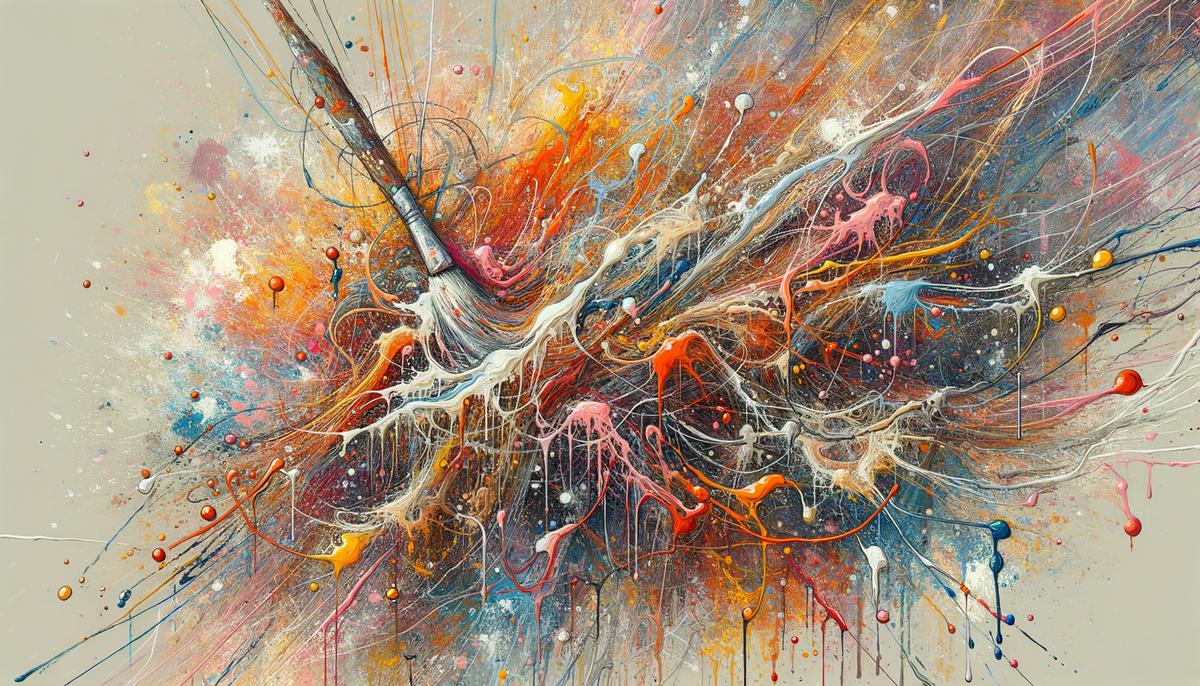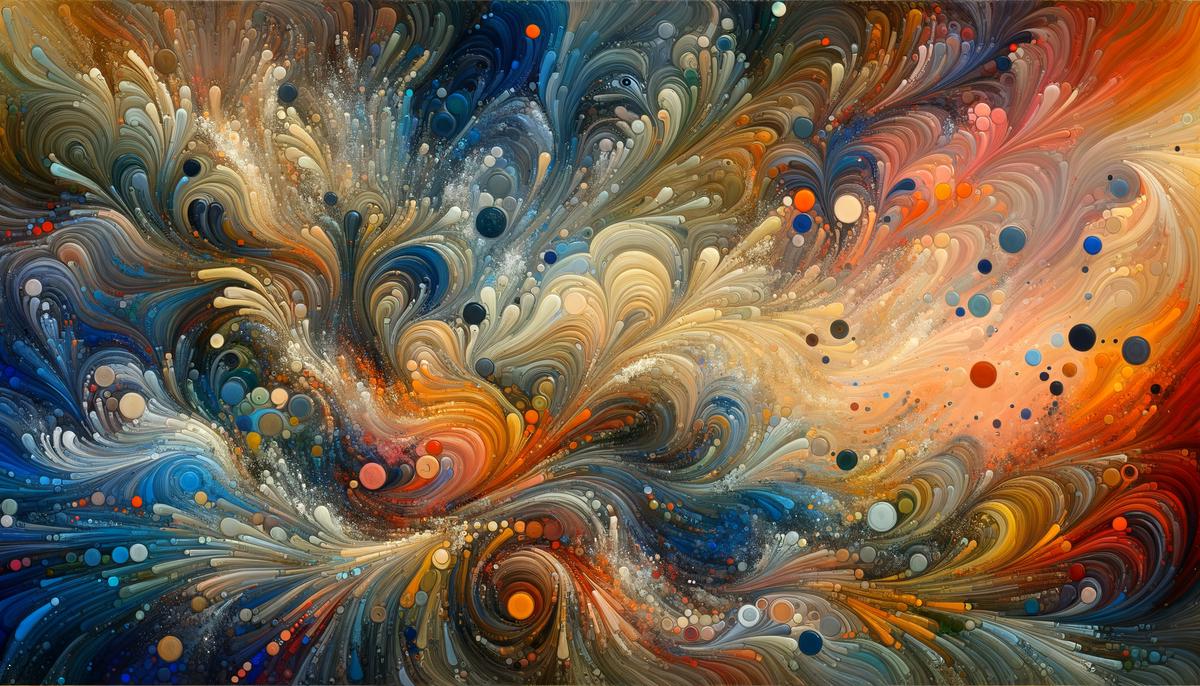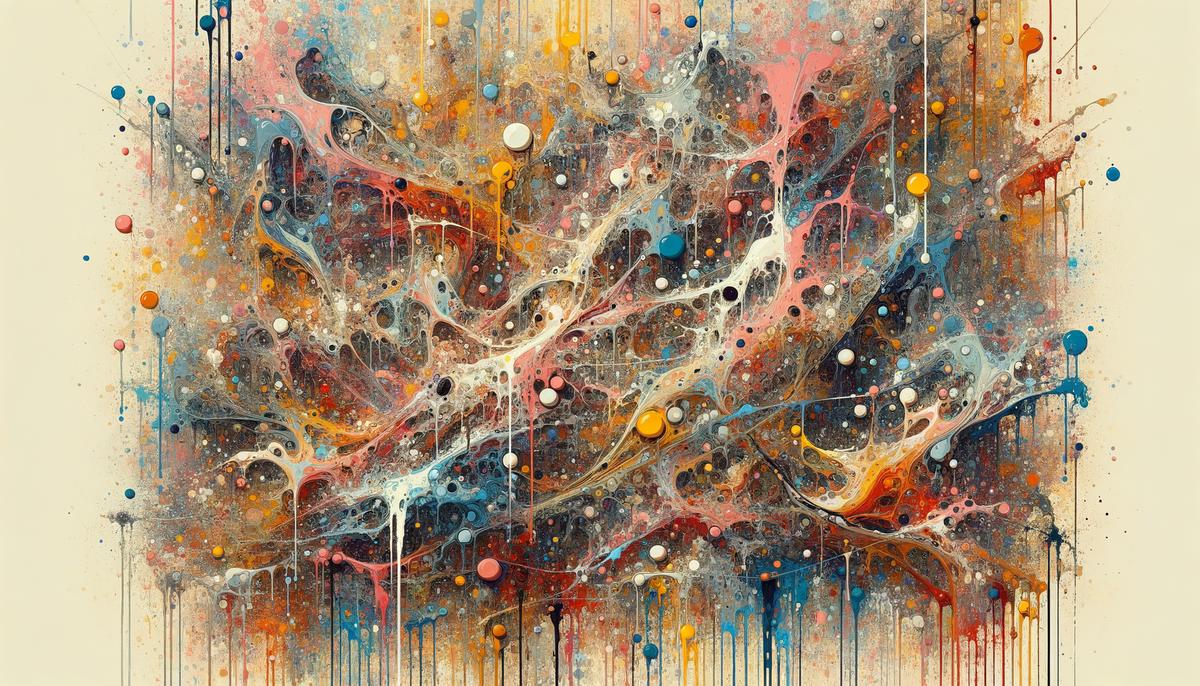Jackson Pollock's approach to art shattered conventional boundaries, introducing a method that was as controversial as it was captivating. His technique, characterized by the energetic application of paint, invites us to reconsider what it means to create. This narrative will guide us through the intricate dance of Pollock's style, the emotional depth of his work, and the lasting impact he has had on the art world. By examining the layers of his influence, we uncover a story not just of a man and his canvas but of a relentless pursuit of expression that defied the norms of his time.
Pollock’s Technique and Style
Jackson Pollock turned the art world upside down with a paint can and a flick of his wrist. His 'drip painting' method strayed far from the norm, breaking free from traditional brush techniques to create works that pulsed with energy and emotion. Imagine the scene: cans of paint, flung across a vast canvas sprawled on the floor, with Pollock orchestrating the chaos like a conductor in front of an unruly orchestra. This wasn't just painting; it was performance.
The physicality of Pollock's process injected a new kind of dynamism into art. Every splatter and streak on the canvas was a direct result of his movements, his rhythm, his mood. It was as if you could see Pollock's dance steps long after the music had stopped, trapped in the layers of paint. His approach wasn't just different, it was revolutionary – to paint without touching the canvas was to redefine what it meant to create art.
Pollock's unconventional tools and materials included:1
- Commercial house paints
- Sticks
- Basting syringes
By stepping beyond the boundaries of accepted media, he emphasized that art wasn't about the materials but how you used them. His innovative spirit encouraged countless artists to experiment and evolve, pushing the limits of what art could be.
The impact of Pollock's style on the art world was seismic. Abstract Expressionism emerged as a leading force, challenging artists and audiences alike to view art through a new lens. Pollock's work became a symbol of freedom and individualism, characteristics revered in post-war America. He demonstrated that emotion and expression could be conveyed through abstract forms, that art didn't have to depict the world literally to be full of meaning.

Influences and Inspirations
Jackson Pollock's distinctive artwork was deeply influenced by his fascination with Surrealism, which permeated his creative process. The movement, known for its exploration of the unconscious mind, spurred Pollock to delve into his psyche, guiding his paint splatters to unravel the layers of human emotion and thought. This connection with Surrealism allowed Pollock's canvases to become landscapes of the mind, where each drip and swirl carried a deeper, often mystifying meaning.
The rich tapestry of Native American art, particularly seen during his time in the American West, also profoundly influenced Pollock. The bold symbols, intricate patterns, and spiritual significance deeply impacted him, infusing his work with a raw, primal energy. This reverence for indigenous art forms is evident in Pollock's rhythmic use of lines and colors, echoing ancient rituals and narratives that dance across his canvases, inviting viewers into a trance-like state.
Pollock's personal struggles, especially his battle with alcoholism, also shaped his artistic vision. Turmoil and despair often found their way into his work, translating into violent clashes of color and frenzied patterns that symbolize his internal conflicts. Yet, these same struggles pushed him towards innovation, as Pollock channeled his pain into creating art that was brutally honest and emotionally charged. His canvases became arenas for confrontation, where Pollock faced his demons head-on, turning anguish into beauty.
Influenced by Carl Jung's concepts of the collective unconscious and archetypes, Pollock sought to access universal symbols buried within his psyche.2 His paintings became visual representations of these archetypal ideas, with abstract forms and shapes emerging as emblematic figures of collective myths and the shared human experience. This exploration of the subconscious added layers of depth to Pollock's work, making each piece a puzzle of psychological insights.
In combining these diverse influences, Pollock revolutionized the art world. His ability to amalgamate elements of Surrealism with Native American influences, personal struggles, and psychoanalytic theory led to the development of a unique visual language. Pollock transcended the canvas's boundaries, creating immersive experiences that invite viewers to navigate through the complex landscapes of emotion, psychology, and spirituality that define his body of work.

Critical Reception and Legacy
Jackson Pollock, while forging a path that shook the foundational understanding of painting, met with a tidal wave of criticism and awe from critics and the public alike. Initially, his drip paintings were perceived as chaotic and rebellious, straying far from the traditional strokes and motifs recognized in high art. A famous article by Life magazine in 1949 presented him as a curiosity, brandishing the headline, "Is he the greatest living painter in the United States?" sparking debates across tables — from coffee spills in diners to the polished mahogany in galleries.3
The dichotomy of responses to Pollock's work highlights a pivotal shift in art criticism. To some, his canvases were a mesmerizing cascade of emotion and energy, an epitome of freedom breaking from the figurative chains. For others, they were nothing but a messy entanglement, lacking the disciplined grace art 'ought to exhibit.' Such polarizing views underlined the struggle between embracing radical innovation versus clinging to the comforting embrace of tradition.
Over time, the narrative began to shift, aligning more cohesively with acknowledgment of Pollock's pioneering spirit. Critical essays and academic inquiries started to dissect the layers beneath the surface chaos of his drip paintings, unveiling the profound control and intent behind each splat and line.
Today, Pollock's work is revered, held on a pedestal in the echelons of modern art. His legacy is not merely seen but felt within the endless streams of artists who dare to break from convention. Contemporary art owes much of its evolution to Pollock's audacity to challenge, to redefine what it means to create. His influence pulsates through various forms — from street art that sprawls vibrantly over brick walls to digital art pushing boundaries in virtual galleries.
Critics today often reflect on Pollock's body of work with a blend of reverence and intrigue, dissecting how his tumultuous personal journey bled into his art, creating a vivid diary of painted emotion. The once divisive conversation has become a unified celebration of his contribution to embracing abstract expression in its rawest form.

Pollock’s Iconic Works
Jackson Pollock's "Autumn Rhythm (Number 30)" and "Blue Poles" are titan pillars in the panorama of 20th-century art, their significance etched deeply in the canvas of art history. "Autumn Rhythm" is a breathtaking constellation of splatters, a symphony in gray, black, and white that cascades across an enormous 207-inch-wide canvas. This masterpiece encapsulates the very essence of nature's unpredictable rhythm and flow. As eyes dance across the painting, one captures the sensation of leaves rustling and branches swaying in a crisp autumnal breeze. Through "Autumn Rhythm," Pollock elevates abstraction to a sensory experience, enveloping onlookers in his emotional landscape.
Meanwhile, "Blue Poles," also known as "Number 11, 1952," marks a stunning departure into a realm swathed in chaos and control. Featuring thickly layered droplets splashed around poles of dripping blue paint, the artwork captures a dynamic tension between underlying order and surface turmoil. "Blue Poles" is noted not just for its visual vibrance but for its rich tapestry of technique and depth, fostering countless interpretations around the themes of growth, struggle, and recovery.
These paintings stand as sentinels to Pollock's revolutionary "action painting" technique—where the act of painting became as significant as the finished piece itself. Here, spontaneity crowns control; the abstract expression not bound by traditional limits but rather evolving across the canvas in ebbs and flows of color and texture.
The core significance of these paintings draws from their embodiment of Pollock's inner maelstrom—his conflicts, triumphs, and the cyclical nature of his existence. Viewers are not merely observers but are thrown into the painter's stormy heart; encouraged not to interpret but to feel. With "Autumn Rhythm" and "Blue Poles," Pollock crafts not just art, but raw, unabashed avenues to voyage into the profoundest recesses of human experience and emotion.
In essence, "Autumn Rhythm" and "Blue Poles" encapsulate the zenith of Pollock's achievements. They are not mere artifacts of bold artistry but enduring emblems of a man who danced on the precipice of creation and destruction. These works provoke dialogue and introspection, existing as vivid manifestations of Pollock's irrevocable imprint on the sphere of abstract expressionism, urging humanity to confront its abyss with unflinching honesty and vigor.
Key facts about "Autumn Rhythm (Number 30)" and "Blue Poles":
- "Autumn Rhythm (Number 30)" was created in 1950 and measures 207 inches wide and 105 inches tall.4
- "Blue Poles" was painted in 1952 and features aluminum and enamel paint on canvas, measuring 83 inches tall and 192.5 inches wide.5
- Both paintings are considered quintessential examples of Pollock's drip painting technique and are highly valued in the art world.

The Role of Patronage in Pollock’s Career
Peggy Guggenheim, an art collector of immense foresight and influence, played a pivotal role in shaping the trajectory of Jackson Pollock's artistry and career. Her patronage provided Pollock not just with financial backing but also with the emotional encouragement necessary for innovation. Pollock's initial encounter with Guggenheim is almost legendary, symbolizing a moment of recognition and opportunity.
Through Guggenheim's intervention, Pollock received a stipend that afforded him the means to rent a barn that would become his famed studio. This space was pivotal for the physical enactment of his art, allowing him hands-on interaction with canvases spread across the floor. This setting was crucial for the development of his signature drip paintings, suggesting that patronage was not only a source of financial support but also an enabler of physical spaces conducive to Pollock's unique way of painting.
Being showcased at Art of This Century, Guggenheim's avant-garde gallery, Pollock's works were positioned within an innovative and influential framework. It was here that his art was seen, critiqued, and eventually celebrated, making evident how critical early exposure, facilitated by Guggenheim, was for Pollock's acceptance and success in the art community.
The validation provided by Guggenheim's sponsorship was instrumental in bolstering Pollock's confidence. Her belief in his potential was mirrored in the attention his work received from critics and collectors alike, establishing his reputation in the broader art world. Herein lays the power of patronage—it shaped not only Pollock's artistic production but also the public's reception and appreciation of his work.
Guggenheim's financial support enabled Pollock to invest in non-traditional materials like aluminum paint and commercial-grade enamel. These materials played a crucial role in the stylistic evolution Pollock underwent, ultimately defining the look and feel of Abstract Expressionism. The freedom to experiment allowed Pollock to transition from traditional mediums to explore the viscosity and fluidity of paints in innovative ways, affecting deeply the visual and textural outcomes of his art.
In essence, Peggy Guggenheim's patronage was a critical adjacency to Pollock's journey into becoming an icon of modern art. It reinforced the notion that behind every burst of creativity lies a support system that nourishes and propels talent into the realm of recognition and reverence. Through her confidence in his genius, Guggenheim not only secured Pollock's place in art history but also underscored the significance of patronage in cultivating artistic revolution.
Key facts about Peggy Guggenheim's patronage of Jackson Pollock:
- Guggenheim provided Pollock with a monthly stipend from 1943 to 1947, allowing him to focus on his art.6
- She hosted Pollock's first solo exhibition at her Art of This Century gallery in 1943, which helped launch his career.7
- Guggenheim commissioned Pollock to create a large mural for her townhouse in 1943, which became a pivotal work in his development of the drip painting technique.8

In the grand tapestry of modern art, Jackson Pollock stands out as a figure who redefined the act of painting. His legacy, marked by a fearless departure from convention, continues to inspire a sense of freedom in artistic expression. The essence of Pollock's contribution lies not in the myriad splatters across his canvases but in his unwavering commitment to authenticity. As we reflect on his journey, it becomes clear that Pollock's true masterpiece was his ability to transform turmoil into beauty, leaving an indelible mark on the canvas of art history.
- Karmel P. Jackson Pollock: Interviews, Articles, and Reviews. New York, NY: Museum of Modern Art; 1999.
- Landau EG. Jackson Pollock. New York, NY: Harry N. Abrams; 2010.
- Coates R. The Art Galleries: Globules. The New Yorker. January 1949:57-58.
- Pollock J. Autumn Rhythm (Number 30). The Metropolitan Museum of Art. https://www.metmuseum.org/art/collection/search/488978. Accessed April 12, 2023.
- Pollock J. Blue Poles. National Gallery of Australia. https://nga.gov.au/internationalpainting/pollock.cfm. Accessed April 12, 2023.
- Naifeh S, Smith GW. Jackson Pollock: An American Saga. New York, NY: Clarkson N. Potter, Inc.; 1989.
- Guggenheim P. Out of This Century: Confessions of an Art Addict. New York, NY: Universe Books; 1979.
- Vail K. Peggy Guggenheim: A Celebration. New York, NY: Guggenheim Museum; 1998.




















